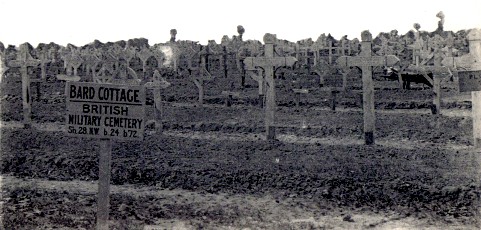George E Kilburn
Date of birth: 1876
Date of death: 14.03.1916
Area: Outwood, Wakefield
Regiment: King's Own Yorkshire Light Infantry
Family information: Husband of Eva Kilburn nee Ramsden
Rank: Private
Service number: 17317
War Service
Shortly after war was declared on the 4th August 1914, Lord Kitchener called for 100,000 volunteers for the New Army. In September 1914 George Ernest Kilburn enlisted in the Kings Own Yorkshire Light Infantry. The rush to volunteer for war was so great that a second service battalion had to be formed within the KOYLI. This battalion was designated the 7th (Service) Battalion, KOYLI and included in its ranks George Kilburn. The 7th KOYLI, which consisted of many Yorkshire miners, was attached to the 61st Infantry Brigade, 20th (Light) Division.
After completing his training on Salisbury Plain, on the 22nd July 1915, Private George Ernest Kilburn crossed the channel to Boulogne, along with the 7th KOYLI. Later the 61st Infantry Brigade moved, by march, to the Armentieres area, where they received instruction in trench warfare.
Towards the end of September 1915 the 7th KOYLI went into the line in the Laventie sector, three miles north of Neuve Chapelle. The Battle of Loos started on the 25th September, but the 7th KOYLI only played a small part in the action. The 7th KOYLI remained in Flanders for some time and in February 1916 they were deployed in the northern part of the Ypres Salient, a particular active area.
On the 11th March 1916 the 7th KOYLI moved into front line positions alongside the Yser Canal. “A” Company, which included Private George Kilburn, was in support on the west bank of the canal. The next two days were fairly quiet, with very little shelling, though an enemy sniper did cause some problems. The 14th March was the last day the Battalion would be in the trenches, before moving into Divisional Reserve and a heavy bombardment of the enemy trenches was planned. The bombardment started at 13.00 hrs and lasted 1 ½ hours, doing considerable damage to the enemy trenches. The enemy retaliation did not last long, but the battalion incurred 9 casualties. At about 17.30 hrs the enemy sent two salvos of HT shrapnel shells over the west canal bank, killing six men instantaneously and seriously wounding ten others. One of those killed was Private George Ernest Kilburn, of “A” Company, who was buried in the nearby Bards Cottage Cemetery at Boesinghe.
For much of the First World War the Belgian village of Boesinghe was directly facing the German lines, across the Yser canal. Bard Cottage was a house, set back from the front line, close to a bridge called the Bards Causeway. The cemetery is nearby, in a sheltered position under a high bank and now contains a total of 1639 Commonwealth burials, 39 of them are unidentified.
Family Life
George Ernest Kilburn was born in 1876, the son of William and Susannah Kilburn of Spa Street, Holbeck, Leeds. Shortly after his birth, his father William Kilburn, who was employed as a factory machine fitter, died. In 1887 his mother married William Prince, a widower and native of Churwell. George Ernest went to live with his mother and step-father at Back Lane, Churwell. On leaving school he found employment as a finisher in a nearby woollen mill, but later worked at a local colliery. In 1897 George Ernest Kilburn married Eva Ramsden and twelve months later their first child, Doris, was born. About this time George and his family were living at Laneside Terrace, Morley and he was employed in the coal mines as a hewer. Later, when George Ernest was working at Lofthouse Colliery, the family lived at Farrar Cottages, on the Waggon Road, at Outwood.
At the time of her husband’s death, Mrs Kilburn and her six children were living at Harrison Cottages, Post Office Lane, Outwood. The children’s ages ranged from 5 years to 13 years of age.
 Bard Cottage Cemetery
Bard Cottage Cemetery

